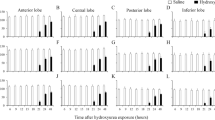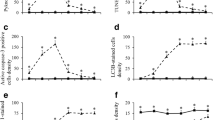Abstract
The morphology, organization and expression of proliferating cell nuclear antigen (PCNA) and the cytoskeletal proteins vimentin and GFAP in immature Bergmann glial cells were studied after a developmental injury induced by a single dose of the cytotoxic agent methylazoxymethanol (MAM) administered on postnatal day 5. This drug, which produces cell death of cerebellar granule cell precursors, did not induce apoptosis in Bergmann glial cells, which are in a proliferative stage. After MAM treatment, PCNA staining showed a severe depletion of PCNA-positive granule cell precursors, whereas PCNA-positive Bergmann glial nuclei in the Purkinje cell layer were preserved. Moreover, the quantitative analysis revealed an increase in the density of both Purkinje cells and PCNA-positive Bergmann glial cells per mm of Purkinje cell layer in MAM-treated rats relative to age-matched controls, but the numerical ratio between these two cell populations remains invariable after MAM treatment. Vimentin and GFAP immunocytochemistry revealed a reinforcement of the Bergmann glial palisade with overexpression of both proteins and thicker immunoreactive glial processes in MAM-treated rats. At the ultrastructural level, Bergmann glial processes closely associated with dying cells in different stages of apopotosis were observed. Frequently, these processes enclosed dying cells in extracellular compartments. Furthermore, phagosomes containing apoptotic bodies were found in Bergmann fibers of MAM-treated rats. These data indicate that the cell death of granule cell precursors triggers a reactive response in immature Bergmann glia. We suggest that this response reflects the plasticity of Bergmann glia to control the neuronal microenvironment in the maturing molecular layer, protecting healthy cells against the potentially harmful contents of dying cells. In situ labeling of cell death with the TUNEL method revealed that the cell death of granule cell precursors is of the apoptotic type. The participation of ameboid microglial cells in the phagocytosis of apoptotic cells was shown with tomato lectin histochemistry and ultrastructual analysis. Moreover, the presence of mitosis in this microglial population demonstrates its proliferative activity in regions of extensive cell death.
Similar content being viewed by others
Author information
Authors and Affiliations
Additional information
Accepted: 2 March 1998
Rights and permissions
About this article
Cite this article
Lafarga, M., Andres, M., Calle, E. et al. Reactive gliosis of immature Bergmann glia and microglial cell activation in response to cell death of granule cell precursors induced by methylazoxymethanol treatment in developing rat cerebellum. Anat Embryol 198, 111–122 (1998). https://doi.org/10.1007/s004290050169
Issue Date:
DOI: https://doi.org/10.1007/s004290050169




